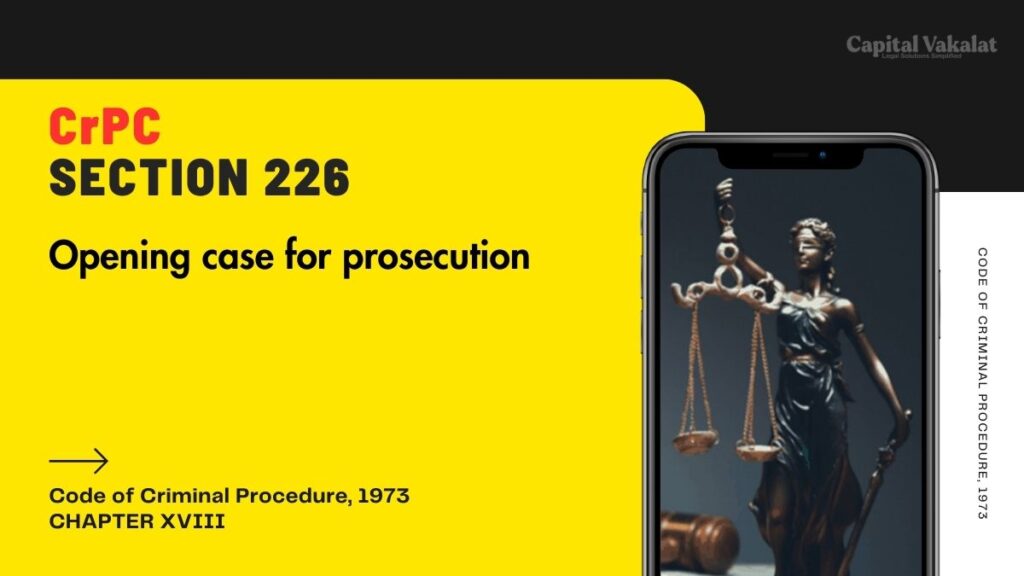The criminal justice system is designed to maintain law and order, delivering justice through a well-structured legal process. Section 226 of the Criminal Procedure Code (CrPC) of India is a pivotal element in this system. It sets the stage for the prosecution to present its case, ensuring that the accused is fully informed of the charges and the evidence against them.

This article delves into the intricacies of Section 226 CrPC, highlighting its importance, procedural requirements, and its impact on criminal trials.
Bare Act. Section 226 Cr.P.C.
Opening case for prosecution.
When the accused appears or is brought before the Court in pursuance of a commitment of the case under section 209, the prosecutor shall open his case by describing the charge brought against the accused and stating by what evidence he proposes to prove the guilt of the accused.
Section 226 CrPC: An Overview
Section 226 CrPC mandates that before the trial begins, the prosecutor must open their case by outlining the charges against the accused and presenting a summary of the evidence they intend to use. This opening statement serves several purposes: it informs the court and the accused of the case’s nature, allows for transparency, and sets the tone for the trial.
Importance of Section 226 CrPC
The significance of Section 226 CrPC lies in its role in ensuring a fair trial. By mandating an opening statement, it prevents any surprises during the trial and allows the defense to prepare adequately. This transparency is essential in upholding the principles of natural justice and the right to a fair trial, which are cornerstones of the legal system.
Procedural Requirements Under Section 226 CrPC
The procedure under Section 226 CrPC requires the prosecutor to:
- Outline the Charges: Clearly state the charges against the accused.
- Present a Summary of Evidence: Provide a concise summary of the evidence that will be presented during the trial.
- Inform the Accused: Ensure that the accused understands the charges and the evidence against them.
The Role of the Prosecutor in Section 226 CrPC
The prosecutor’s role is critical in the initial stages of a criminal trial. They must meticulously prepare their case, ensuring that all evidence is gathered and presented in a manner that is both clear and compelling. This preparation involves extensive coordination with law enforcement, witnesses, and forensic experts to build a strong case against the accused.
Challenges in Implementing Section 226 CrPC
Despite its importance, there are several challenges in implementing Section 226 CrPC effectively:
- Complexity of Cases: In complex cases involving multiple charges or defendants, summarizing the evidence succinctly can be challenging.
- Coordination with Law Enforcement: Ensuring that all evidence is collected and presented accurately requires effective coordination with various agencies.
- Legal Expertise: The prosecutor must have a deep understanding of the law and the ability to present the case convincingly.
Impact of Section 226 CrPC on Criminal Trials
Section 226 CrPC significantly impacts criminal trials by ensuring that both the prosecution and defense are adequately prepared. This preparation helps in streamlining the trial process, reducing delays, and ensuring that justice is delivered efficiently. Additionally, it upholds the accused’s right to be informed of the charges against them, which is a fundamental aspect of a fair trial.
The Defense’s Perspective on Section 226 CrPC
From the defense’s viewpoint, Section 226 CrPC is crucial as it provides them with an early understanding of the prosecution’s case. This knowledge allows the defense to prepare their strategy effectively, identify potential weaknesses in the prosecution’s case, and gather evidence and witnesses to counter the charges.
Judicial Interpretations of Section 226 CrPC
Over the years, various judicial pronouncements have shaped the interpretation of Section 226 CrPC. Courts have emphasized the need for a clear and concise opening statement, ensuring that the accused is not caught off guard. These interpretations have reinforced the section’s role in promoting transparency and fairness in criminal trials.
Case Studies Highlighting Section 226 CrPC
Several landmark cases have highlighted the importance of Section 226 CrPC. For instance, in the case of State of Maharashtra v. Priya Sharan Maharaj, the Supreme Court underscored the necessity of a clear opening statement by the prosecution. Such cases serve as precedents, guiding future interpretations and implementations of the section.
Reforms and Recommendations for Section 226 CrPC
To address the challenges in implementing Section 226 CrPC, several reforms have been suggested:
- Training for Prosecutors: Regular training programs to enhance the skills and expertise of prosecutors.
- Improved Coordination: Establishing better coordination mechanisms between law enforcement agencies and the prosecution.
- Technological Integration: Utilizing technology to streamline evidence collection and presentation.
Conclusion
Section 226 CrPC is a cornerstone of the Indian criminal justice system, ensuring transparency and fairness in trials. By mandating an opening statement from the prosecution, it safeguards the rights of the accused while promoting a thorough and efficient legal process. Despite the challenges in its implementation, continuous reforms and judicial guidance can enhance its effectiveness, ensuring that justice is delivered swiftly and fairly.